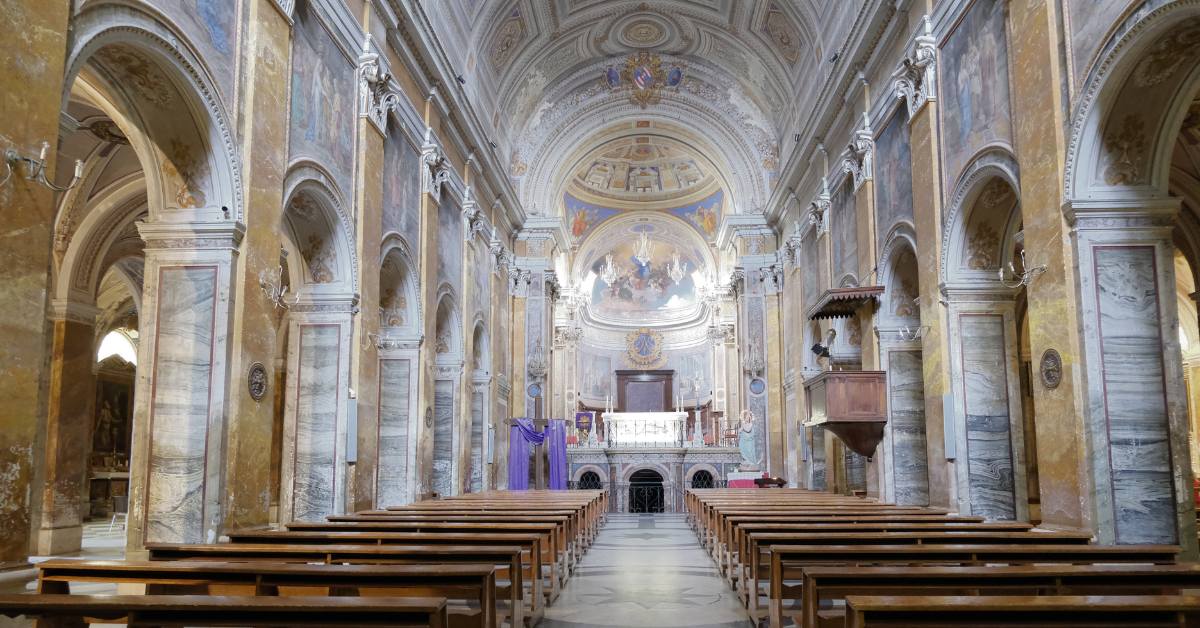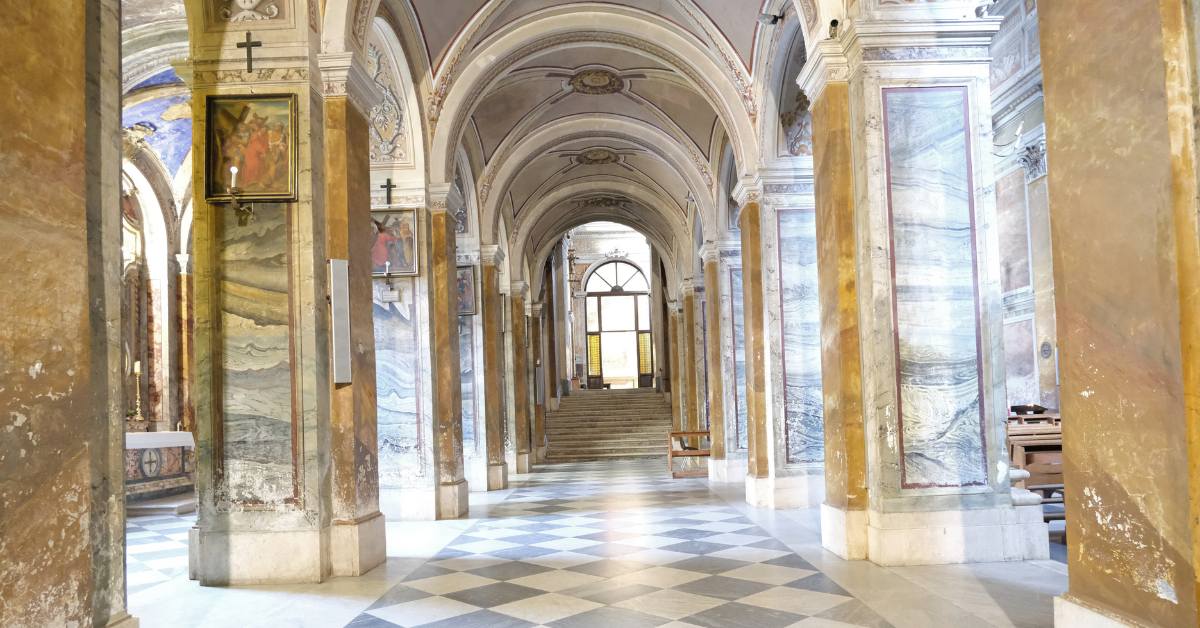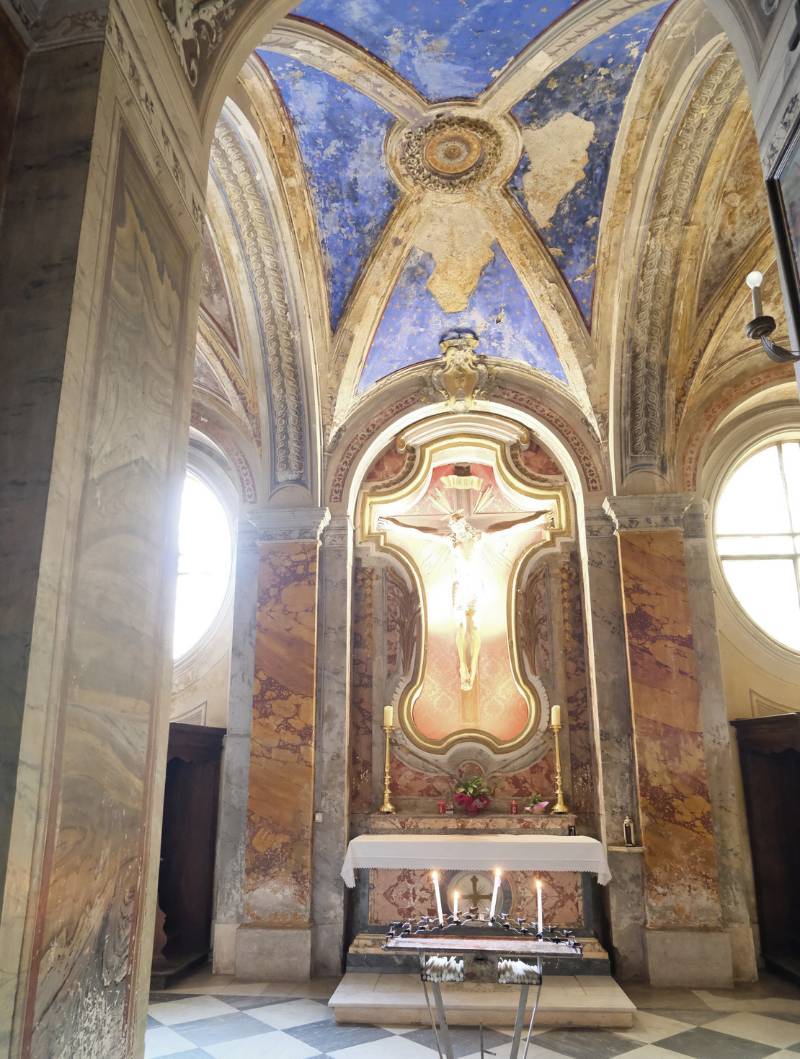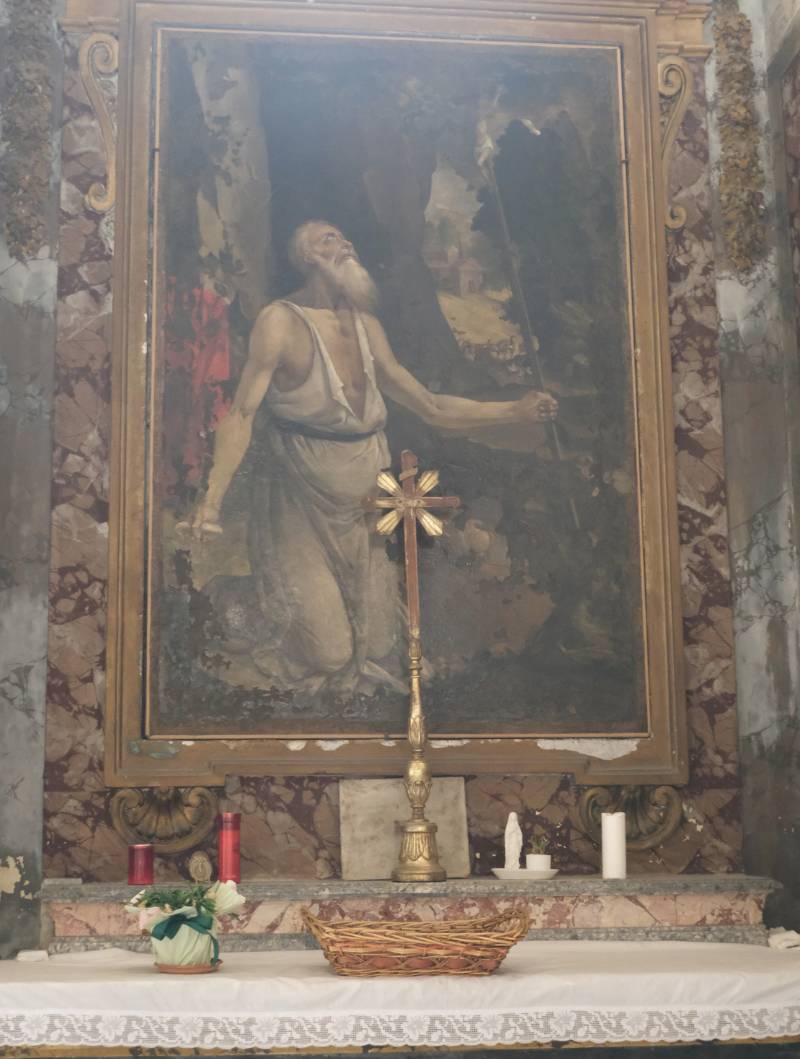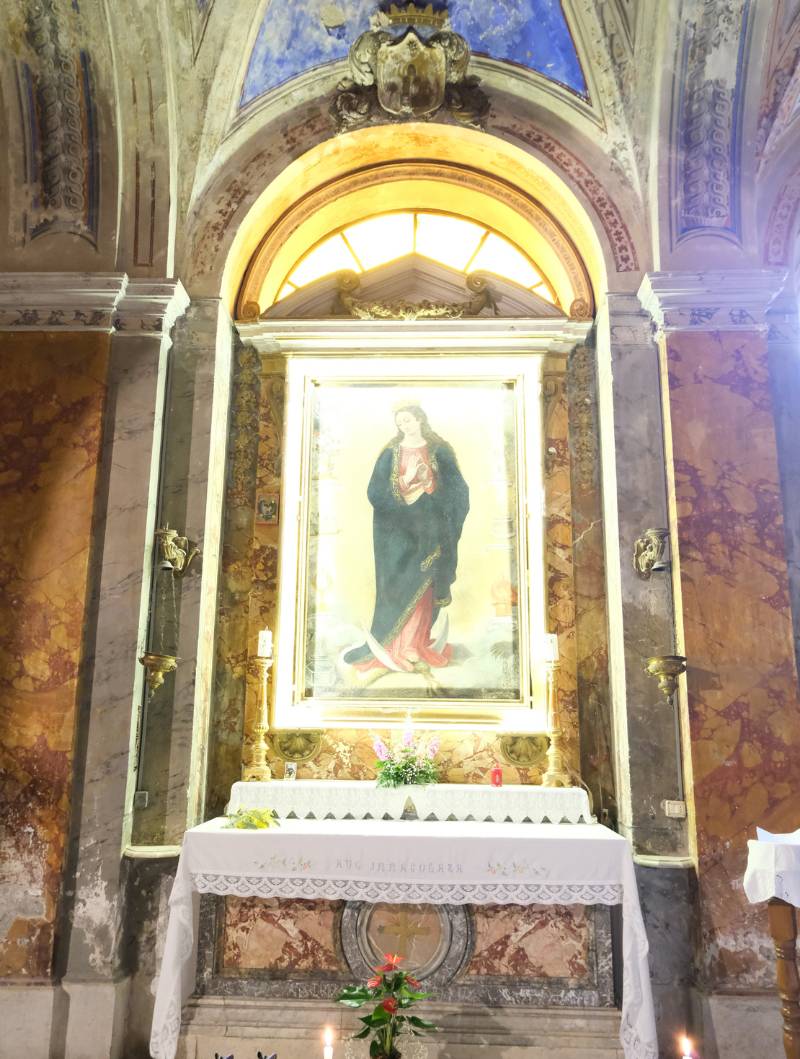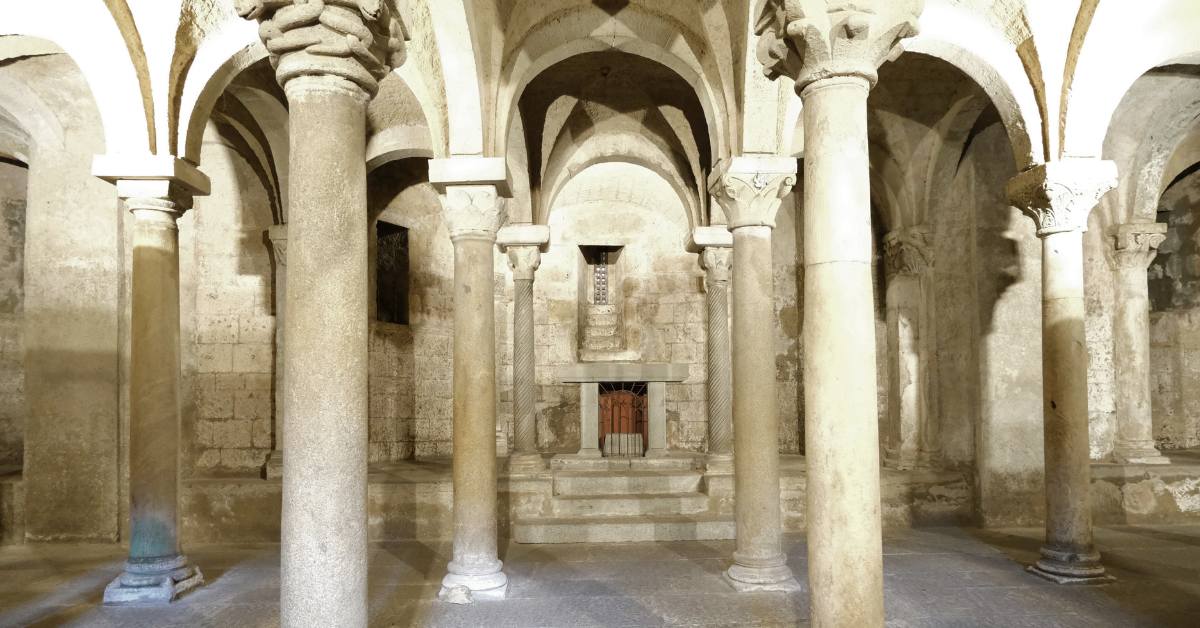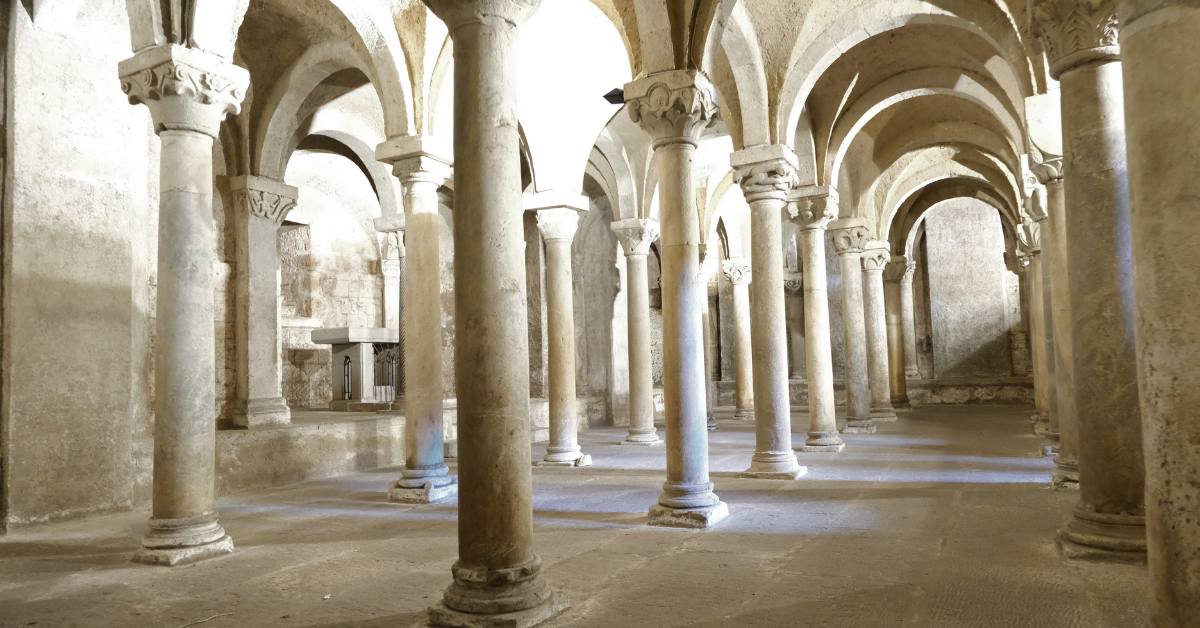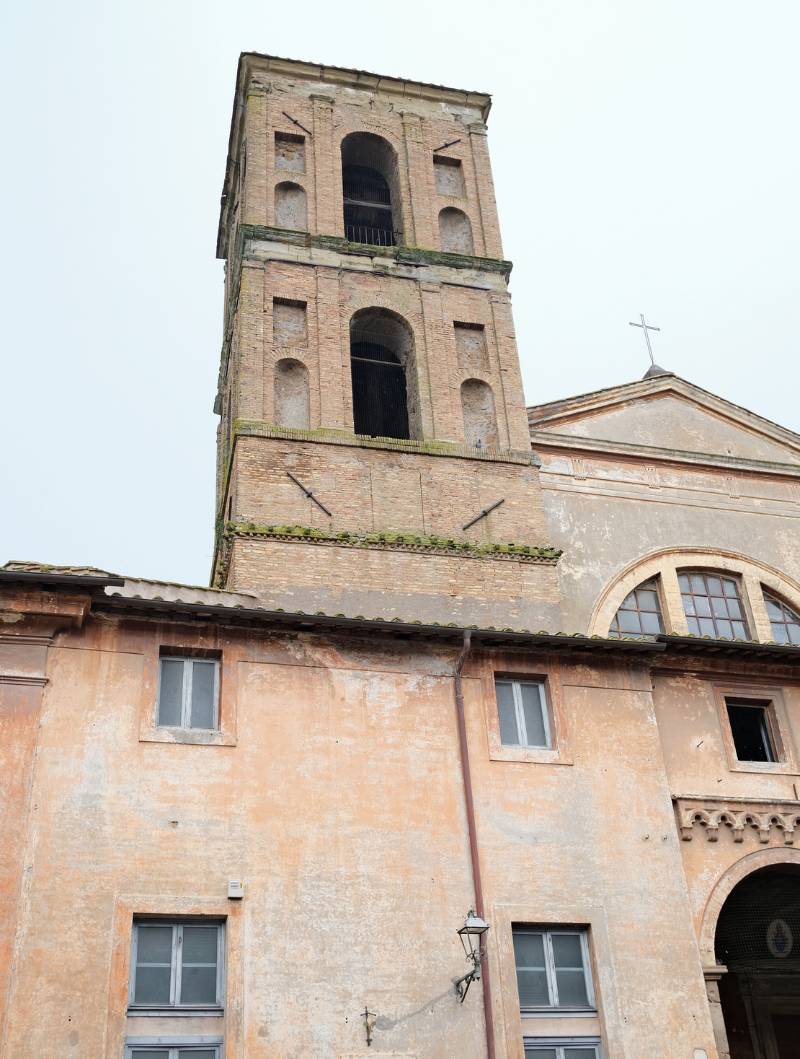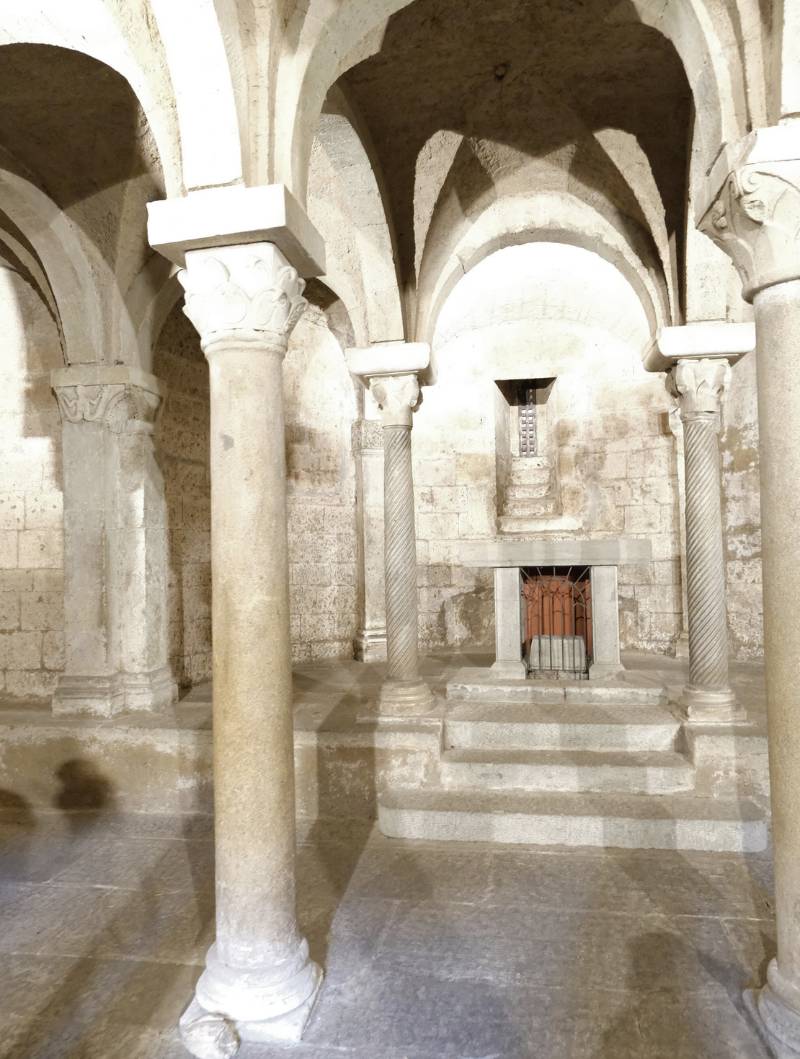In the heart of the city of Nepi stands the Cathedral, a silent guardian of centuries of art, history, and devotion. This page is designed for those who wish to immerse themselves in the grandeur of the Nepi Cathedral, offering an in-depth journey through its historical roots, its impressive architecture, the priceless works of art it houses, and much more.
The Origins and History of the Nepi Cathedral
Tradition holds that the Cathedral of Santa Maria Assunta was built on the site of an ancient place of worship dedicated to the Roman temple of Jupiter. The presence of wall fragments in the portico, dating back to the 2nd-3rd centuries, attests to the deep historical stratification of the site.
A key document for understanding the origins of the Cathedral is the Ravenna papyrus of Nepi from 557, which confirms the Christian faith was deeply rooted in this place from the early centuries. Although it is unclear whether the original cathedral was located exactly where the current Duomo stands, it is known that the structure retains parts dating back to the 12th century, including the magnificent crypt and the base of the bell tower.
The crypt, with its rectangular floor plan and divided into nine small aisles by 24 columns, ends with three apses. The capitals, unique in their design and decorated with plant motifs, as well as human and fantastic figures, are a striking example of Romanesque style.
An inscription within the Cathedral commemorates its consecration in 1266 by Bishop Lorenzo, marking the completion of works that began in the 12th century. Originally conceived with three naves, the structure underwent significant changes between the 16th and 17th centuries, including the reconstruction of the main nave ceiling and the portico.
Subsequent expansions led to the creation of the fourth and fifth naves, the latter added in 1752, as evidenced by an inscription.
However, in 1798, a fire caused by French troops caused significant damage to the cathedral, destroying wooden elements and part of the furnishings.
The Rebirth
After the disaster, it was Anselmo Basilici, Bishop of Nepi from 1818 to 1840, who led the reconstruction of the Cathedral. The interiors were later enriched with new frescoes, with particular emphasis on the figure of Mary, celebrated in twelve episodes along the central nave and in the image of the Assumption in the apse.
The walls of the Choir are adorned with two works that depict significant moments in the life of Saint Romano: his episcopal consecration and his profession of faith before martyrdom. These frescoes were created by Domenico Torti and Ludovico De Mauro between 1868 and 1873, marking an important phase in the sacred decoration of the Cathedral, which continues to be a spiritual and artistic landmark for the community of Nepi. The last major structural intervention took place in 1901, when the flooring was replaced.
The Artistic and Architectural Masterpieces of the Cathedral
Entering the Cathedral of Nepi, one can immerse themselves in the discovery of an invaluable artistic and spiritual heritage. From the naves that house centuries-old works of art, to the presbytery that tells stories of faith and devotion, to the side chapels that safeguard relics and historical memories, every corner of this cathedral invites exploration into the depth of religious and artistic tradition. Every detail of the Duomo di Nepi is a chapter in an open book on history, art, and spirituality, ready to be discovered and admired.
Central Nave
The heart of the church, the central nave, stands out for its frescoes created between 1868 and 1873 by Ludovico De Mauro. These works reflect the depth of artistic tradition and Marian devotion, culminating with the masterpiece by Domenico Torti, the Coronation of the Blessed Virgin Mary, surrounded by figures of saints closely tied to the community and its history, including Saints Pius V, Savinilla, Ptolemy, and Roman, the patrons of Nepi. Torti left an indelible mark with the twelve depictions along the nave that illustrate the Life of Mary, from key moments such as the Annunciation and the Nativity to more intimate scenes like the Visit of Mary to Saint Elizabeth, presenting a visual narrative of her earthly and spiritual life. This sequence of frescoes not only beautifies the sacred space but also serves as a tool for visual catechesis for the faithful.
Left Lateral Nave
The left lateral nave opens with the Chapel of the Immaculate Conception, adorned with the altar by Bernardino Brozzi, a work financed by the Sansoni family in the 17th century, reflecting the intertwining of faith, art, and local patronage. Continuing, one encounters the Chapel of the Most Holy Crucifix, where the wooden statue of Christ stands out, crafted by Antonio Ispanico between 1532 and 1533, a powerful symbol of sacrifice and redemption. The third chapel is dedicated to Saint Jerome, depicted in a moment of penance, an evocative image of asceticism and spiritual conversion. The nave concludes with a tribute to Luigi Maria Olivares, bishop for 27 years, whose tomb is a place of memory and veneration.
At the other end of the space, two significant entrances stand out: the first leads the way to the stairs ascending to the bell tower, while the second, topped by a venerable sculpture of the Madonna and Child dating back to the 12th century, opens to what was once a storage room. Next to these doors, a wall inscription echoes a historically important moment for the ecclesiastical community: the last celebration of the Diocesan Synod. This event, held on October 8, 1907 and presided over by Giuseppe Bernardo Doebbing, the Franciscan bishop of Nepi and Sutri, revived a tradition that had not been celebrated for 112 years, bringing together canons and clergy from both dioceses in a solemn and fruitful assembly, marking a significant moment in the life of the church and its community.
Right Lateral Nave
In the right corridor of the Duomo, there are chapels of notable historical and artistic interest. The first of these houses an ancient baptismal font from 1577, behind which one can admire a fresco depicting the baptism of Christ in the Jordan River, carefully restored in 1982. Continuing, one encounters the second chapel, dedicated to Saint Isidore the Farmer, whose altar, dating back to the 17th century, was also restored in 1982, reaffirming the community’s connection with the land and agricultural labor.
The third chapel is a tribute to Saint Joseph, depicted at the moment of his death, surrounded by Jesus and Mary: a work commissioned by the Confraternity of Saint Joseph, as evidenced by the coat of arms proudly displayed in front of the altar. Next, the fourth chapel celebrates Saint Philip Neri, a 17th-century figure, with an altar made possible through the generous contributions of the Floridi and Viterbini families, as indicated by the coat of arms and the keystone.
The fifth and final chapel is dedicated to the Most Blessed Sacrament, also known as the Madonna della Salute. Here, a painting from 1884, signed by C.F., depicts the Madonna surrounded by Saints Joseph and Camillus de Lellis, creating a place of deep spirituality and reflection. This chapel also preserves the memory of His Excellency Monsignor Giuseppe Gori, Bishop of Nepi and Sutri for 27 years, whose life, spanning from May 19, 1885, to July 2, 1969, is commemorated here in respect and veneration.
The Presbytery and Side Chapels
Accessible via the side stairs, the Presbytery reveals its full majesty, crowned by a false dome that plays with perspective, embracing within it sacred figures from the family of Mary of Nazareth – including Saints Anne, Joachim, Elizabeth, Joseph, Zachariah, Mary of Cleopas, and John the Baptist – as well as Old Testament prophets such as Isaiah, Moses, David, and Ezekiel, whose prophecies are deeply connected to the figure of the Virgin Mary. Among the decorations, two frescoes by Domenico Torti stand out, illustrating the martyrdom of the patron saints Saint Romano and Saint Ptolemy, and the imposing depiction of the Assumption of Mary into heaven, a masterpiece located in the apse area. Also significant are Torti’s signatures, one evidenced on the stone marking the decapitation of Saint Romano and the other on the harp held by King David, confirming the dating of the work to 1838.
Central to the Presbytery is the high altar, adorned with a marble sarcophagus from Carrara, created by Ercole Ferrata, a disciple of Bernini, on August 2, 1688. This monument not only houses the relics of Saint Romano but is also marked by the memory of an attack in 1798, as evidenced by the damage to the nose of the statue of Saint Romano. The inscription inside the Cathedral details the consecration of the altar and the list of relics contained within, celebrating a moment of profound spirituality and ecclesiastical history.
The side chapels of the Presbytery further enrich this sacred space. On the left side, the chapel dedicated to the Assumption of Mary houses a statue of Saint Pius V, while on the right side stands the Chapel of the Evangelists, with an altar painting dating back to 1580 and works depicting the Annunciation and other biblical moments, created by Viterbese artists such as Filippo Capozzi and Giovanni Porta, known as Salviati. This space is further enhanced by marble statuettes of the four Evangelists and bas-reliefs of Saints Ptolemy and Romano, elements that reflect a deep connection with local tradition and devotion, also evidenced by a marble candelabrum from the 1650 Jubilee, which survived the historical vicissitudes and fires that marked the church’s past.
Transept and Bishop’s Passage Room
Located above the entrance to the right transept is the Triptych of the Savior, a highly valuable work that marks the artistic history of Nepi during the late 16th century. The attribution of this work goes to Marcello Venusti (1512/13 – 1579), although there was a historical misunderstanding that led it to be attributed to Giulio Romano. The triptych features, at the center, the image of the Savior, flanked by panels depicting Saint Ptolemy, Saint Romano, the Archangel Gabriel, and the Virgin Mary. Until 2017, this important artistic testimony was placed in the center of the apse. In the same room, one can observe the door adorned with the episcopal emblem, the historic entrance to the secret passage that directly connected the cathedral to the episcopal palace.
The Sacristy
The sacristy of the Duomo houses true artistic gems from various periods, including works by Antonio del Massaro, known as Il Pastura. These paintings depict Saints Ptolemy and Romano, showcasing the talent and devotion of the painter.
Alongside them, one can admire four meticulous portraits of the Holy Apostles: Peter, Bartholomew, Thaddeus, and Matthew. These 17th-century works, created by the skilled hand of Mattia Preti, represent a significant part of the cycle dedicated to the Apostles. Their presence in Nepi is the result of a transfer by Marcello Anania, Bishop of Nepi between 1654 and 1670 and mentor to the artist, who sought to enrich the sacristy with these precious testimonies of faith.
At the left entrance of the cathedral, a plaque placed in memory by Mario, brother of Marcello Anania, commemorates the bishop and his passing on April 25, 1670. This act of remembrance further emphasizes the deep connection between the diocese of Nepi and the figures who contributed to its history and artistic and spiritual heritage.
The Crypt
Even today, the fascinating Crypt can be admired, an architectural jewel from the 11th-12th century, supported by 46 imposing marble columns. Of these, 26 occupy a central position, each crowned with unique capitals depicting a variety of animals and symbols from the medieval bestiary. Particularly remarkable are the two central spiral columns, relics from an ancient pagan temple. This sacred space originally housed three altars, testifying to the deep spirituality that permeates the crypt. The most recent restoration took place in 1951, initiated by His Excellency Monsignor Giuseppe Gori, Bishop of Nepi and Sutri, to celebrate the 19th centenary of the martyrdom of Saints Ptolemy and Romano, venerated as the city’s first bishops.
Entrance and Portico
The façade of the Duomo is announced by an elegant trilobed portico, erected in 1438, which serves as the guardian of a collection of marble artifacts, testimonies of various historical periods. Among these, the following stand out: an inscription from 1131 that records the first communal agreement of Nepi, a fragment of the original Cosmatesque floor from 1266 in opus alexandrinum, an imperial-era sarcophagus decorated with mythological scenes of Phaethon’s fall, a Roman monument, along with a series of tombstones and noble coats of arms. In 1647, under the aegis of Bishop Bartolomeo Vannini, a new portico was built, as evidenced by the inscription on the architrave of the main entrance: “DEIPARAE MARIAE VIRGINI ASSUMPTAE BARTOLOMEUS VANNINUS EPISCOPUS NEPESINUS ET SUTRINUS AN. MDCIIIL.”
Inside the room on the left, sacred furnishings and vestments belonging to the Confraternity of the Most Holy Sacrament are displayed. A special dedication stands above the main door on Via G. Matteotti, commemorating the construction of the fifth nave of the Basilica, a project completed by Bishop Giacinto Silvestri in 1752: “Giacinto Silvestri, Bishop of Nepi and Sutri, erected from the foundations the fifth nave of this ancient Basilica. In the year 1752.”
The High Altar and the Triptych of the Holy Savior
Inside the Duomo, one of the most precious artistic treasures is represented by the majestic sculptural work that adorns the high altar. This piece, created by Ercole Ferrata, a distinguished disciple of Bernini, depicts a touching scene: Saint Romano lies in repose, while Saint Savinilla covers him with a funeral veil. Created in 1680, this sculpture was designed to stand above the urn that holds the sacred relics of the saint, enriching the altar with deep spiritual symbolism.
Another masterpiece that adorns the Duomo is the Triptych of the Holy Savior, carefully positioned in the presbytery area. At the center, the figure of the Savior stands majestically, flanked by panels depicting Saint Ptolemy, Saint Romano, the Archangel Gabriel, and the Virgin Mary, creating a visual ensemble of extraordinary emotional and devotional power.
Although popular tradition attributes this work to Giulio Romano, art experts tend to disagree with this assertion, while universally recognizing that the triptych is a product of the mid-16th century, a period of vibrant artistic creativity.
The Bell Tower and Organ: Symbols of Community
The bell tower, rebuilt several times over the centuries, symbolizes the resilience of the Nepi community in the face of adversity. Over the years, the tower has undergone several transformations. The construction we see today began in 1507, replacing an old, ruined Saracen tower, under the guidance of Pierino da Caravaggio. A few years later, in 1511, Jacopo Ungarico da Caravaggio completed the work, as confirmed by a document held in the State Archives of Viterbo. This document also attests to the replacement of part of the previous tower, built in the Romanesque-Lazio style. The current tower reveals a base dating back to the 9th century, followed by a level added in the 12th century, and finally, a Renaissance section completed later. These layers are still clearly visible in the walls.
Just above the church roof, the medieval part of the structure can be seen, characterized by two closed windows and red brick decorations. Above it rises the Renaissance section of the tower, divided into three levels with a solid base and two upper floors adorned with large arches and decorative niches.
The bell tower has suffered significant damage due to lightning strikes on several occasions: the first on January 1, 1773, again on January 5, 1858, and finally during a vigil in the cathedral on March 22, 1922. Fortunately, the latter incident caused no casualties, as the tower collapsed onto the main street. Following these events, the original spire was replaced with a four-pitched roof..
Inside the tower are three bells dedicated to the Assumption of the Virgin Mary and Saints Ptolemy and Romano, bearing witness to the historical and spiritual richness of this place.
The organ, present since 1443 and later enhanced with a wooden structure by Angelo Morettini in 1855, still accompanies religious services with its solemn music on special occasions, contributing to the spiritual atmosphere of the Duomo.
Visiting the Nepi Cathedral: Useful Information
The Nepi Cathedral is open to visitors and worshippers who wish to explore its beauty and spirituality every day from 7:30 AM to 12:15 PM and from 3:00 PM to 6:30 PM.
Even today, the Cathedral hosts the most significant celebrations of the Nepi community, from Communions to Confirmations, including the celebration of the Midnight Mass and the Corpus Christi service after the traditional Infiorata. Throughout the year, various concerts are also held inside the Nepi Cathedral, such as the traditional Saint Stephen’s Day Concert and several other classical music events or choir performances.
Location
Piazza del Duomo, 2 Nepi (VT)

